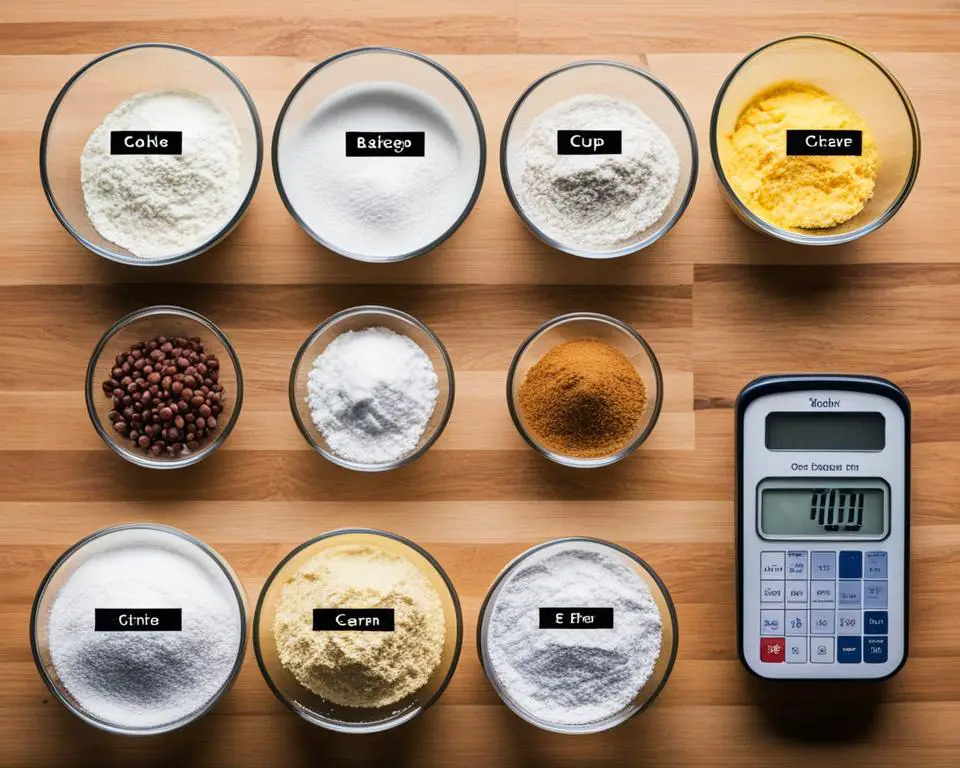Have you ever wondered how many grams are in a cup? This guide will help you convert measurements of common cooking and baking ingredients from cups to grams. Measuring ingredients in cups can be less accurate than measuring by weight, especially in baking where precise amounts are important.
There are two main systems of measurement: the United States Customary System (used in the US) and the Metric System (used in most other countries). Grams can be used to measure both solid and liquid ingredients. In the US, a standard 1-cup measuring cup is equal to 240 ml or 240 grams when measuring liquids. There are different types of cups, so it’s important to use the correct measuring cup for accurate measurements.
This guide provides conversion charts for various ingredients such as flours, sugars, liquids, and dry goods. Proper measurement is crucial for successful baking, so it’s recommended to use a kitchen scale for the most accurate results.
Key Takeaways:
- Converting measurements from cups to grams is essential for precise baking and cooking.
- The United States Customary System and the Metric System use different cup measurements.
- Using the correct measuring cup is important for accurate results.
- A kitchen scale is recommended for the most precise measurements.
- The conversion charts provided in this guide will help you measure various ingredients accurately.
Conversion Charts for Common Baking Ingredients
Accurate measurement is essential in baking, and converting measurements from grams to cups can be helpful. This section provides conversion charts for common baking ingredients such as flours, sugars, liquids, and dry goods.
Let’s start with all-purpose flour. One cup of all-purpose flour weighs approximately 125 grams. If you’re using bread flour, keep in mind that one cup weighs around 130 grams. On the other hand, cake flour is lighter, with one cup weighing about 115 grams.
But it’s not just about flours. The charts also cover other important ingredients like corn flour, baking powder, cocoa powder, granulated sugar, confectioner’s sugar, and a variety of dry goods.
For accurate measurements in your recipes, it’s essential to know the cup to gram ratio. These conversion charts will help you determine the equivalent grams for a specific cup measurement and vice versa. With precise measurements, you can ensure that your baked goods turn out perfectly every time.
Take a look at the conversion chart below to get started. It will provide you with the necessary information to confidently convert measurements from grams to cups.
Conversion Chart: Common Baking Ingredients
| Ingredient | Grams (1 cup) | Cups (per 125 grams) |
|---|---|---|
| All-Purpose Flour | 125g | 1 cup |
| Bread Flour | 130g | 0.96 cups |
| Cake Flour | 115g | 1.08 cups |
By referring to this conversion chart, you’ll be able to achieve precise measurements and confidently adapt recipes that use cup measurements. Say goodbye to guesswork and hello to perfectly measured ingredients in your baking adventures!
Tips and Tricks for Accurate Measurement
While conversion charts can be helpful, it’s important to use proper measuring techniques to ensure accurate measurements. This section provides tips and tricks for measuring ingredients in cups without a kitchen scale.
One important tip is to spoon flour into the measuring cup rather than scooping or packing it. This method helps prevent excess flour that can lead to dry and dense baked goods. By spooning the flour gently into the cup and then leveling it off with a knife, you can achieve a more precise measurement.
When it comes to measuring liquid ingredients, a liquid measuring cup is essential. These cups have a spout and markings specifically designed for measuring liquids. Pour the liquid into the cup and check the measurement at eye level for accuracy.
For semi-liquid ingredients like yogurt or peanut butter, it is best to spoon them into a dry measuring cup. This will help you achieve a consistent and accurate measurement. Use the back of a spoon to level off the ingredient and ensure an exact amount.
If you have questions about the weight of specific ingredients, here are a few common examples:
- Water: 1 cup weighs approximately 240 grams.
- Milk: 1 cup weighs approximately 240 grams.
- Butter: 1 cup (2 sticks) weighs approximately 226 grams.
- Oats: 1 cup weighs approximately 90 grams.
- Rice: 1 cup weighs approximately 200 grams.
- Flour: 1 cup weighs approximately 125 grams.
Follow these tips for accurate measurements:
- Use the appropriate measuring cup for each ingredient.
- Spoon flour into the cup, rather than scooping or packing it.
- Use a liquid measuring cup for liquids and a dry measuring cup for semi-liquid ingredients.
- Level off the ingredients with a straight edge for precise measurements.
By following these tips and using conversion charts, you can achieve precise measurements in your recipes and improve your baking skills. Now you’re ready to confidently create delicious dishes with accurate measurements.
Start Baking with Confidence
Now that you have a better understanding of how to convert measurements from cups to grams, you can confidently tackle recipes that use cup measurements. Whether you have a kitchen scale or need to rely on conversion charts, you’ll be able to achieve precise measurements for your baking and cooking adventures.
Remember to use the correct measuring cup for accurate results and follow proper measuring techniques. Using a kitchen scale is the most accurate way to measure ingredients, but if you don’t have one, don’t worry! Conversion charts can help you convert cup measurements to grams and vice versa.
With these tools and tips, you’ll be on your way to perfect baking and cooking with precise measurements every time. Say goodbye to guesswork in the kitchen and hello to delicious recipes made with confidence!

